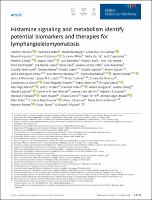Histamine signaling and metabolism identify potential biomarkers and therapies for lymphangioleiomyomatosis

Author
Date
2021-09-07Permanent link
https://hdl.handle.net/11351/7403DOI
10.15252/emmm.202113929
ISSN
1757-4684
WOS
000683691400001
PMID
34378323
Abstract
Inhibition of mTOR is the standard of care for lymphangioleiomyomatosis (LAM). However, this therapy has variable tolerability and some patients show progressive decline of lung function despite treatment. LAM diagnosis and monitoring can also be challenging due to the heterogeneity of symptoms and insufficiency of non-invasive tests. Here, we propose monoamine-derived biomarkers that provide preclinical evidence for novel therapeutic approaches. The major histamine-derived metabolite methylimidazoleacetic acid (MIAA) is relatively more abundant in LAM plasma, and MIAA values are independent of VEGF-D. Higher levels of histamine are associated with poorer lung function and greater disease burden. Molecular and cellular analyses, and metabolic profiling confirmed active histamine signaling and metabolism. LAM tumorigenesis is reduced using approved drugs targeting monoamine oxidases A/B (clorgyline and rasagiline) or histamine H1 receptor (loratadine), and loratadine synergizes with rapamycin. Depletion of Maoa or Hrh1 expression, and administration of an L-histidine analog, or a low L-histidine diet, also reduce LAM tumorigenesis. These findings extend our knowledge of LAM biology and suggest possible ways of improving disease management.
Keywords
Biomarker; Histamine; LymphangioleiomyomatosisBibliographic citation
Herranz C, Mateo F, Baiges A, Ruiz de Garibay G, Junza A, Johnson SR, et al. Histamine signaling and metabolism identify potential biomarkers and therapies for lymphangioleiomyomatosis. EMBO Mol Med. 2021 Sep 7;13(9):e13929.
Audience
Professionals
This item appears in following collections
- HVH - Articles científics [4471]
The following license files are associated with this item:

 Private area
Private area Contact Us
Contact Us







